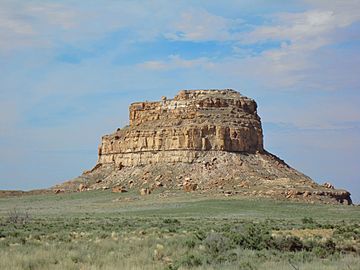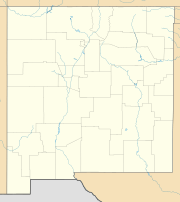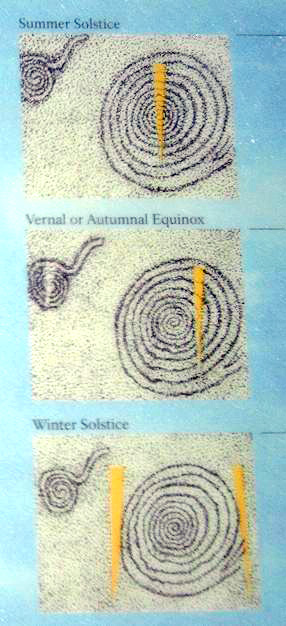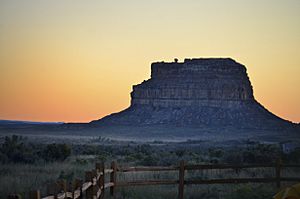Fajada Butte facts for kids
Quick facts for kids Fajada Butte |
|
|---|---|

Fajada Butte mid-morning
|
|
| Highest point | |
| Elevation | 6,623 ft (2,019 m) NGVD 29 |
| Geography | |
| Location | San Juan County, New Mexico, U.S. |
| Topo map | USGS Pueblo Bonito |
| Geology | |
| Age of rock | Cretaceous |
| Mountain type | Sandstone |
| Climbing | |
| First ascent | circa 850 AD |
| Easiest route | closed to visitors |
Fajada Butte is a special butte (a tall, flat-topped hill with steep sides) located in Chaco Culture National Historical Park in New Mexico, USA. It's a really important place because of its history and a cool ancient calendar found there.
This butte rises about 135 meters (443 feet) above the canyon floor. Even though there's no water source on top, people long ago built small cliff dwellings high up on the butte. Scientists have studied pieces of pottery found there. These studies show that people used these structures between the 10th and 13th centuries.
There are also signs of a huge ramp on the southwestern side of the butte. This ramp was about 95 meters (312 feet) high and 230 meters (755 feet) long! Building something so big without a clear everyday use suggests that Fajada Butte was very important for ceremonies to the ancient Chacoan people.
Contents
The Sun Dagger: An Ancient Calendar
In 1977, an artist named Anna Sofaer was helping to record ancient rock art in Chaco Canyon. She found some amazing petroglyphs (rock carvings) on Fajada Butte. This spot is now famous as the Sun Dagger site. It's on a cliff near the top of the butte that faces southeast.
How the Sun Dagger Works
At this site, three large stone slabs lean against the cliff. These slabs work together to create special patterns of light and shadow on two spiral carvings on the cliff wall. Anna Sofaer noticed a "dagger of light" that perfectly cut through one of the spirals.
- Summer Solstice: Around 11:15 AM on the longest day of the year (the summer solstice), a dagger-shaped light shines right through the center of the larger spiral.
- Winter Solstice and Equinoxes: Similar "sun daggers" also mark the shortest day of the year (the winter solstice) and the equinoxes (when day and night are about equal length).
The site also tracks the moon! At certain times in the moon's 18- to 19-year cycle, shadows from the rising moon align with the spirals. This shows how incredibly skilled the ancient Chacoan people were at observing the sky.
Protecting the Site
Sadly, one of the stone slabs shifted over time. This happened partly because of people walking on the butte. Because of this shift, the "dagger of light" no longer crosses the spiral exactly as it used to during the summer solstice.
To protect this delicate and important site, the National Park Service closed Fajada Butte to visitors in 1989. This was to prevent more damage from erosion caused by foot traffic. In 1990, the stones were made stable and are now watched carefully. However, the shifted slab was not moved back to its original spot.
Studies by Anna Sofaer's Solstice Project suggest that many major buildings of the ancient Chacoan culture were also built with the sun and moon cycles in mind. Their directions, shapes, and how they related to each other all connected to the movements of the sun and moon.
Discussions About the Sun Dagger
There are some interesting discussions about the Sun Dagger site. Some experts wonder exactly when the spiral carvings were made. Others debate how important the site was. While other ancient observatories used light to predict events over time, this one works differently. Some even suggest that the people who made the carvings simply used rocks that were already there, rather than building the whole setup.
Most experts agree that the light and shadow patterns at the site were meant to mark the solstices and equinoxes. However, there's less agreement about the moon patterns. Some researchers point out that ancient Pueblo people could track the sun more precisely using horizon observations than with the Sun Dagger site. This leads some to believe it might have been a special sun shrine, rather than a calendar used to manage daily life.
See also
 In Spanish: Butte de Fajada para niños
In Spanish: Butte de Fajada para niños
- Archaeoastronomy
- Fajada Gap




